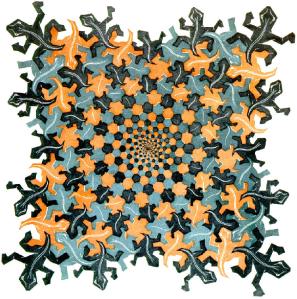Maurits Cornelis Escher is one of my most appreciated artists, for years he has been a great source of inspiration throughout my own artwork. I’m a great admirer of how Escher represents the perfect combination of two completely different subjects coming together; mathematics and art.
Escher was a Dutch graphic artist who specialised in Woodcuts and Lithographs. He was born in Leeuwarden, Friesland on 17th June 1898. He was the youngest son to George Escher and his second wife Sara Gleichman. Escher didn’t do very well in school failing many subjects; although always outstanding in art he had no formal training in mathematics. As a young artist while visiting the Alhambra in Spain, he became deeply inspired and fascinated by the intricate geometric decoration of the Moorish tiles within. So much so that one may consider it being a defining moment for Escher as an artist.

- Fig 1. (Alhambra: Mexuar, Alan Kohl, 2011)
After visiting the Alhambra, Escher spent most of his life experimenting in a field of mathematics known as tessellation. Tessellation is all about the numerous geometric tiles which divide a plane, a plane being the equivalent to a page in some cases. One may think that the use of tessellation is a simple concept comprising of regular tiles that fit together without any overlapping, in this case that maybe so, but tessellation is fundamental to mathematics and the reason being is that it’s about symmetry. Escher likes to add a human yet fantastical dimension to what may seem simple abstract shapes; his work includes strange creatures consisting of little animals, reptile like creatures, goblins and demons.


Escher’s professional life splits into two different stages, his early work is very instinctive and he’s inspired by tessellations. It’s only after being in contact with mathematicians that his work is based around deeper mathematics, dimensions in the shape of space, illusions and infinity. Escher’s work is inspiring to cosmologists even today, who believe Escher anticipated features of modern cosmology.

Below, (fig 5) Escher’s ‘Circle Limit III’ was made in 1959, it’s one of four woodcuts. Mathematicians regard it as the best in the series for being so perfect geometrically. Using basic sketching tools Escher created this astonishing representation of space as it edges towards the infinite. Mathematicians 40 years later approve and have firmly established that it’s one hundred percent accurate even down to the last millimetre. What makes it the best of the four is that it’s the best representation of infinity. We can only imagine infinity; Escher’s objective was to portray it in a closed composition form. In Circle Limit III, the demonstration of infinity is the outward reduction of the size of the fish, each time reducing the size by half until the circle encloses an infinite number of fish. The fish are swimming head to tail, this clearly epitomises the range of infinity from negative to positive. Mathematicians and scientists know their subject is beautiful, Escher demonstrates this to us visually.

Fig 1. Kohl, A. (2011) Alhambra: Mexuar, [ONLINE]
Available: http://smarthistory.khanacademy.org/alhambra.html Last Accessed 26th Nov 2013.
Fig 2. Escher, M.C. (1938) Cycle, [ONLINE]
Available: http://www.mcescher.com/ Last Accesed 26th Nov 2013
Fig 3. Escher, M.C. (1939) Development II, [ONLINE]
Available: http://www.mcescher.com/ Last Accesed 26th Nov 2013
Fig 4. Escher, M.C. (1960) Circle Limit IV, [ONLINE]
Available: http://www.mcescher.com/ Last Accesed 26th Nov 2013
Fig 5. Escher, M.C. (1959) Circle Limit III, [ONLINE]
Available: http://www.mcescher.com/ Last Accesed 26th Nov 2013
Escher,M.C. Available: http://www.mcescher.com/. Last accessed 26th Nov 2013.


Pingback: Workshop: Escher Tessellation ‘CUTE to UGLY’ Transformation | MONIR KHAN